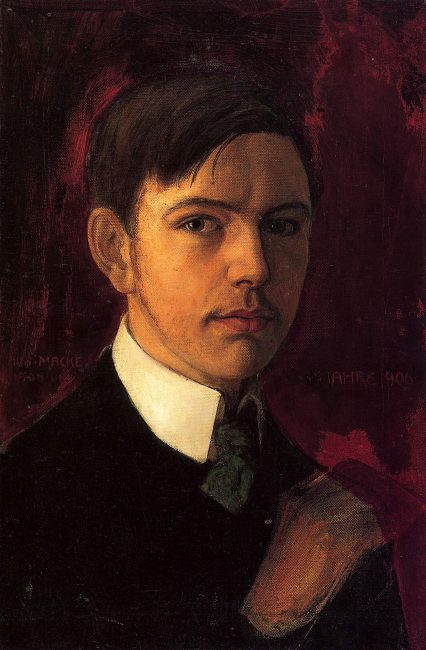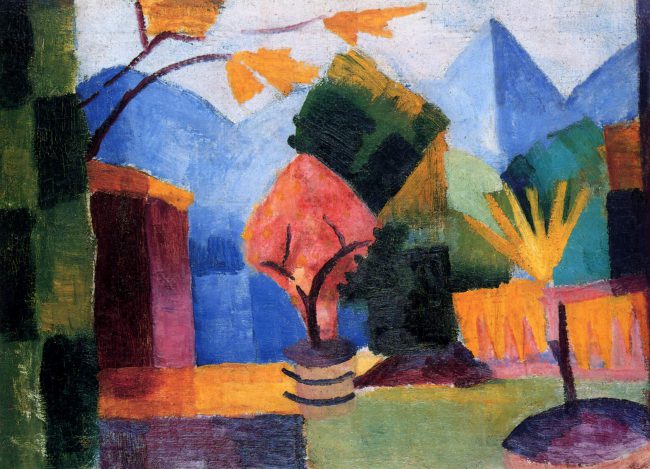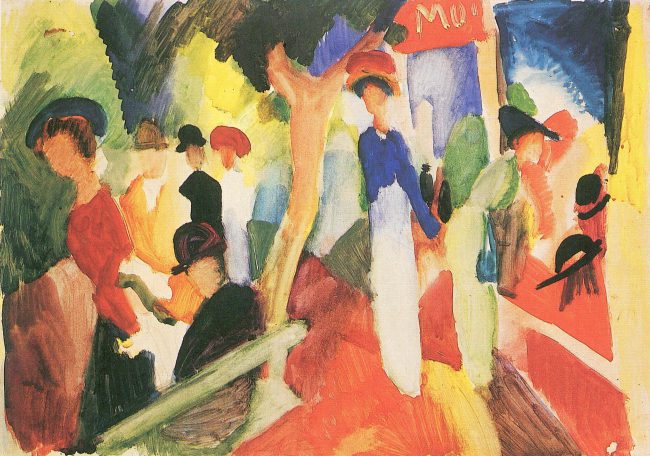
August Macke (1887 – 1914)
On January 3, 1887, German expressionist painter August Macke was born. He was one of the leading members of the German Expressionist group Der Blaue Reiter (The Blue Rider). In about ten years Macke created a body of work that initially underwent rapid stylistic changes under the influence of the diverse art movements of the time. Like a true artist of his time, Macke knew how to integrate into his painting the elements of the avant-garde which most interested him.
“Cubism, Futurism, Expressionism, abstract painting, are only names given to a change which our artistic thinking wants to make and is thinking. Nobody has ever painted fallen raindrops suspended in the air, they’ve always been depicted as streaks (even the cave-men drew herds of reindeer in the same way). Now people are painting cabs rattling, lights flickering, people dancing, all-in the same way (this is how we all see movement). That is thew whole frightfully simple secret of Futurism. Its very easy to prove its artistic feasibility, for all the philosophizing that has been raised against it. Space, surface and time are different things, which ought not to be mixed together, is the continuous cry. If only it were possible to separate them. I can’t do it.”
– August Macke, in a letter to philosopher Eberhard Grisebach, March 1913
August Macke – Family Background
August Macke was born in Meschede, Sauerland, Germany. His father August Friedrich Macke (1845-1904), a civil engineer and moderately successful building contractor, drew in his spare time and collected old engravings and coins. His mother Maria Florentine Macke, née Adolph (1848-1922) came from a peasant family. Soon after August’s birth, the family moved to Cologne, where he attended high school from 1897. After moving again to Bonn, he transferred to the Realgymnasium there in 1900. During his school years, August Macke demonstrated a talent for drawing and painting and a lively interest in art. In 1903 he met his future wife Elisabeth Gerhardt, the daughter of the Bonn factory owner Carl Gerhardt. Elisabeth became his most important model from then on; he painted portraits of her more than two hundred times. Her uncle, the wealthy Berlin entrepreneur, art collector and patron Bernhard Koehler, would later support Macke on several occasions.
From Stage Design to Impressionism
In 1904, against his father’s wishes, he left school in the Unterprima and began training at the Royal Academy of Art in Düsseldorf. He soon criticized the rigid curriculum and especially the continual drawing from plaster casts. He attended the academy only occasionally and left prematurely in November 1906. At the same time, in 1905, he took courses at the Düsseldorf Kunstgewerbeschule, which provided him with more inspiration. Through Wilhelm Schmidtbonn, a friend of his, he came into contact with Louise Dumont and Gustav Lindemann, who were striving to reform the theater at the Düsseldorf Schauspielhaus. With great enthusiasm, August Macke designed stage decorations and costumes for a series of performances in 1906. On a trip to Paris in 1907, Macke became acquainted with Impressionist paintings that deeply impressed him. He then decided to supplement his training with a German Impressionist. His choice fell on Lovis Corinth, who gave courses at a private art school in Berlin. During his six-month study stay, Macke also visited many Berlin museums.
Military Service and Franz Marc
From October 1908 he did his one-year military service, which almost completely interrupted his artistic work. After completing his military service, he married Elisabeth Gerhardt in October 1909. The couple’s existence was secured by income that Elisabeth Macke received from her paternal inheritance, which allowed for a not luxurious but carefree existence. The honeymoon again led to Paris, where August Macke encountered works by the Fauves and the Futurists. On the occasion of an exhibition he met Franz Marc at the beginning of 1910.[1] He soon became close friends with Franz, who was seven years his senior, and had a lively exchange of ideas on artistic issues. In September 1910, he visited an exhibition of the Neue Künstlervereinigung München, where works by the Fauves and the incipient Cubism were shown, among others. In November 1910, the family returned to Bonn. More than 330 paintings were created during the Bonn period. The Bonn student Max Ernst became friends with Macke in 1911 and, encouraged by the recognition and encouragement of Macke’s circle of friends, decided the following year to become a painter.

August Macke, Spaziergänger am See I (1912)
Der Blaue Reiter
In mid-1911, two members of the Neue Künstlervereinigung, Wassily Kandinsky and Franz Marc, decided to launch their own publication, the almanac Der Blaue Reiter, which, however, only appeared once.[2] Prompted by Marc, Macke participated in the editing of the almanac and contributed the essay Die Masken (The Masks); he also arranged for Bernhard Koehler to secure the financing. When the editors of the Almanac left the artists’ association at the end of 1911 to organize their own exhibitions under the name Der Blaue Reiter, Macke joined them. In the first exhibition of the Blaue Reiter, which was shown in 1911/12, first in Munich, then in Cologne, Berlin, Hagen and Frankfurt, Macke was represented with only three paintings, through which he felt inadequately represented. His relationship to the Blaue Reiter had always been ambivalent; while he was at times deeply impressed by Kandinsky’s painting, he had reservations about the artists’ high intellectual standards as well as about Kandinsky’s dominant personality. Although he attended the second exhibition of the Blaue Reiter, which took place from February to April 1912 and featured graphic works, he had already distanced himself artistically from the group by this time.
The Bonn Years
The three Bonn years were a time of lively exhibition activity for Macke. Exhibitions in renowned galleries ensured that his reputation grew beyond Germany, including participation in an exhibition of Karo-Bube (Jack of Diamonds) in Moscow. In addition, he appeared as an organizer of important exhibitions. At the Gereonsklub in Cologne, he showed works by avant-garde artists who had previously been little known there, and he championed the presentation of the Blaue Reiter in the Rhineland. Distancing himself from the Blue Rider, he advised his friend Marc to “work without thinking of the ‘Blue Rider’ and blue horses.” He painted a picture titled Persiflage auf den Blauen Reiter in 1913. The watercolor shows Marc left of center on the carriage seat, Kandinsky to the right of him sitting nobly in the carriage, and the profile of Herwarth Walden in the upper right. On the lower right Macke presents himself small and insignificant. The painting is covered in flowing lines and splashes of color, caricaturing Kandinsky’s abstract style.

August Macke, Garten am Thuner See (1913)
War and Death
At the outbreak of World War I, Macke was drafted into Infantry Regiment No. 160 on August 1, 1914. His letters from the field reflect the horrors and cruelty of war. He fell on September 26, 1914, at the age of 27, as a deputy officer on the Western Front at Perthes-lès-Hurlus in Champagne. Macke is buried in a collective grave in the military cemetery at Souain.

August Macke, Hutladen an der Promenade (1914)
Work and Legacy
August Macke was open to the diverse artistic currents of his time and experimented with the new painting styles in his pictures. Due to the changing influences, his work shows a rapid stylistic change despite the short creative period of about ten years. The painting Spaziergänger am See I (Stroller by the Lake, 1912) marks a decisive turning point in Macke’s work. Sharp-edged, acute-angled forms are juxtaposed here in jerky dynamics; the unity of the picture plane is dissolved. Macke was reacting to the impressions of early Cubism with its forerunners Pablo Picasso [3] and Georges Braque.[4] Initially, he even adopted the dark, muted colors of this style of painting, which were quite untypical for him. In contrast, the prismatic, overlapping and overlapping elements that also appear in Macke’s paintings and drawings since 1912 can be traced back to influences of Futurism. Its concern was, among other things, to express speed through the simultaneous depiction of successive processes. August Macke did not completely follow any of these art movements, but took the elements that suited him and developed his personal, unmistakable style from them. The objects are now simplified (often as geometric shapes) and subordinated to the color composition, but the figurativeness is not completely abandoned. The colors shine, there are no more hard contours. This is exemplified by Garden at Lake Thun from 1913, one of Macke’s few pure landscape paintings. The painter had now found his most important subjects: Woman(s) in front of shop windows, strollers in the park, animals in the zoo. In many of the paintings there is motionlessness; the people are turned away from the viewer, often they keep their heads lowered and their eyes closed as if in meditation. The paintings often have something dreamlike about them. They show Macke’s vision of a paradisiacal world.
Cornelia Faye, Friday Morning Lecture & Tour Series | German Expressionist Art 1905-1937, [13]
References and Further Reading:
- [1] Franz Marc – German Expressionism and Der blaue Reiter, SciHi Blog
- [2] Wassily Kandinsky – the First Expressionist, SciHi Blog
- [3] Pablo Picasso – A Giant in Art, SciHi Blog
- [4] Georges Braque and the Invention of Cubism, SciHi Blog
- [5] Cornelia Feye, Friday Morning Lecture & Tour Series | German Expressionist Art 1905-1937, The San Diego Museum of Art
- [6] Works by August Macke at Zeno.org.
- [7] August Macke Haus in Bonn
- [8] Works by or about August Macke at German Digital Library
- [9] Material about or by August Macke at documenta archive
- [10] “August Macke – The Complete Works – Biography”. augustmacke.org.
- [11] Works by or about August Macke at Internet Archive
- [12] August Macke at Wikidata
- [13] Cornelia Faye, Friday Morning Lecture & Tour Series | German Expressionist Art 1905-1937, 2021, The San Diego Museum of Art @ youtube
- [14] Timeline for August Macke, via Wikidata





